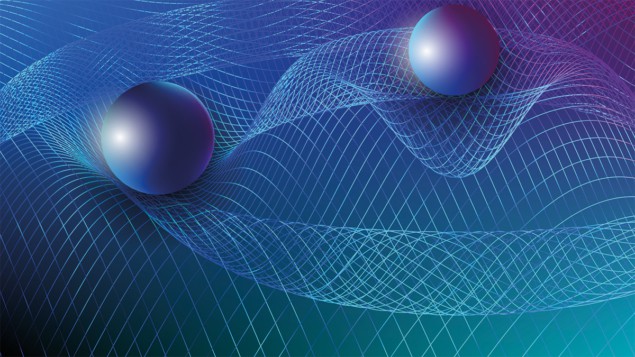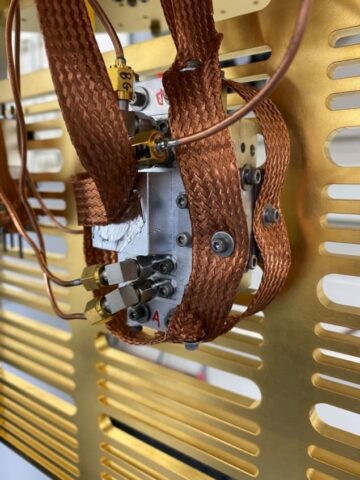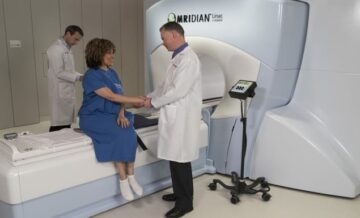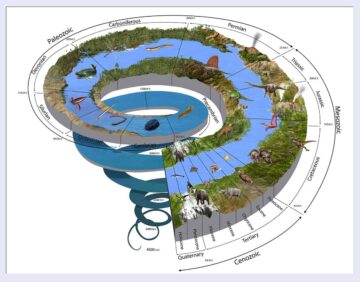
Quantum bits (qubits) based on cold atoms are increasingly attractive candidates for quantum computing. However, targeting single atoms in an array with lasers to manipulate them individually for processing quantum information remains a challenge. Now, Francesco Cesa and Hannes Pichler at Austria’s University of Innsbruck have designed a new protocol for quantum computation that does not rely on targeting individual atoms. Other researchers are now trying to implement the protocol in the lab.
Quantum computers should be able to perform some calculations that are beyond the capability of even the most powerful conventional supercomputers. However, the technology is still in an early phase of development and it is not clear what type of qubits are best. Today, qubits based on superconducting circuits are the most advanced – but qubits based on arrays of cold ions have also found success.
More recently, arrays of ultracold neutral atoms have also been investigated for use as qubits. Atoms are attractive because they are stable, scalable, identical in nature and controllable thanks to advances in laser technologies. Atoms can be excited to Rydberg states, allowing the atoms to interact and become entangled – which is a key process in quantum computing.
Quantum adjustments
In atomic arrays, lasers form regularly-spaced optical tweezers to hold the atoms in place. Other lasers are used to adjust the quantum states of the atoms by either exciting them; nudging them to release energy and return to their ground state; or leaving the atom in a superposition of energy states. Superposition being useful for quantum computing.
The lasers that manipulate the states of the atoms typically illuminate the entire array, which makes it difficult to process quantum information held in individual atoms. However in 2022, a team of researchers in the US and UK demonstrated the targeting of single atoms with laser beams. Also that year, a team that included Pilcher took a different approach by moving single atoms within an array
“I am a big fan of that approach,” Pichler tells Physics World, but he adds that there could be benefits to an approach that does not require so much control of individual atoms.
Cesa agrees, “Indeed, current results on local addressing are very promising – and very exciting – but that remains one of the most delicate aspects of computation with Rydberg atoms,”. He adds, “It is understood that one would prefer to use such a delicate tool as little as possible, and mostly rely on global controls.”
Strung along
In their new protocol, each qubit is a string of atoms called a wire. Each wire can exist in one of two quantum states or in a superposition of the two. Cesa explains, “at each step of the computation, the information is stored in a subset of the atoms” in each wire. This subset comprises “interface atoms” that lie between two sections of wire made up of atoms that are ordered differently in terms of their excited and ground states. In a standard configuration, the atoms on one side of an interface alternate between the ground and excited Rydberg states and the atoms on the other side are all in the ground state.
Within a wire, an atom cannot be excited when it is within a certain distance from another excited atom – a distance called the “Rydberg blockade radius”. This means that an incident pulse will only excite the atoms on one side of the interface. Whether the first atom after the interface atom changes state depends on the state of the interface atom. In this way the interface and the information it encodes can move up the wire as the system is pulsed – or back down the wire if the pulses are inverted.
So far, the information moving up and down the line is unchanged. Change occurs when the interface atom encounters “superatoms”. These are clusters of atoms at or in-between certain sites in an array of wires that can change the state of the qubit. This effectively processes quantum information held within an array.
“You can see it as either encoding the algorithm in the [configuration of the] superatoms or in the pulse sequence that moves around your information,” Pichler explains. He adds, “I think it’s beautiful that it connects natural dynamics of quantum many body systems to quantum information processing in a very transparent way”.
Complementary protocols
Pichler points out that their protocol could complement techniques that target individual atoms “as an additional knob in designing quantum processors”. Certain processes could use the targeted approach, while other subroutines may be achieved efficiently by globally addressing the entire array. “By employing our ideas, one can drastically reduce the calls to individual atom control, and judiciously decide when to use it,” adds Cesa.
Mark Saffman at the University of Wisconsin in Madison is an expert on targeting single atoms. He describes the new protocol as an “unexpected solution for achieving universal quantum computation with globally controlled arrays of Rydberg interacting atoms”.

New neutral-atom qubit offers advantages for quantum computing
He told Physics World that the requirement for controlling the position and quantum state of individual atoms “puts a heavy burden on the requirements of the optical control system. The global approach by Cesa and Pichler removes that requirement, which may make the path to scalability shorter.” However, he also points out that that the “architecture does not yet incorporate error correction, which will undoubtedly be needed to reach quantum advantage for the most demanding applications”.
Pichler and Cesa agree, and they see error correction as the next key task. “This is a new way of quantum processing and it requires a new way of thinking about how to suppress errors,” says Pichler. He notes that since each qubit uses a string of atoms – not just one atom – the process might naively be considered more susceptible to errors. However, the effects of errors remain to be seen.
Cesa and Pichler have already identified features that can be exploited to help with error correction, pointing out that most of the atoms in each wire qubit do not have information associated with them. “You don’t need fully fledged quantum error correction to correct errors on this sort of idle atom,” Pichler explains.
Pichler and Cesa suggest that the protocol could also benefit other quantum-computing platforms such those based on superconducting circuits.
The protocol is described in a paper that will appear in Physical Review Letters and in a preprint available on arXiv.
- SEO Powered Content & PR Distribution. Get Amplified Today.
- PlatoData.Network Vertical Generative Ai. Empower Yourself. Access Here.
- PlatoAiStream. Web3 Intelligence. Knowledge Amplified. Access Here.
- PlatoESG. Carbon, CleanTech, Energy, Environment, Solar, Waste Management. Access Here.
- PlatoHealth. Biotech and Clinical Trials Intelligence. Access Here.
- Source: https://physicsworld.com/a/quantum-computing-protocol-avoids-targeting-individual-atoms-in-an-array/
- :is
- :not
- $UP
- 2022
- 90
- a
- Able
- About
- achieved
- achieving
- Additional
- addressing
- Adds
- adjust
- advanced
- advances
- ADvantage
- advantages
- After
- algorithm
- All
- Allowing
- already
- also
- am
- an
- and
- Another
- appear
- approach
- ARE
- around
- Array
- AS
- aspects
- associated
- At
- atom
- attractive
- available
- back
- based
- BE
- beautiful
- because
- become
- been
- being
- benefit
- benefits
- BEST
- between
- Beyond
- Big
- Blue
- body
- burden
- but
- by
- calculations
- called
- Calls
- CAN
- candidates
- cannot
- capability
- certain
- challenge
- change
- Changes
- clear
- cold
- Complement
- components
- comprises
- computation
- computers
- computing
- Configuration
- connects
- considered
- control
- controlled
- controlling
- controls
- conventional
- correct
- could
- creates
- Current
- Dark
- decide
- demanding
- demonstrated
- depends
- described
- designed
- designing
- Development
- different
- difficult
- distance
- do
- does
- Dont
- down
- drastically
- dynamics
- each
- Early
- effectively
- effects
- efficiently
- either
- employing
- energy
- Entire
- error
- Errors
- Ether (ETH)
- Even
- excited
- exciting
- exist
- experiment
- expert
- Explains
- exploited
- fan
- far
- Features
- First
- For
- form
- found
- from
- fully
- Global
- Globally
- Green
- Ground
- Have
- he
- heavy
- Held
- help
- hold
- How
- How To
- However
- http
- HTTPS
- ideas
- identical
- identified
- Idle
- if
- illuminate
- image
- implement
- in
- incident
- included
- incorporate
- increasingly
- individual
- Individually
- information
- interact
- interacting
- Interface
- issue
- IT
- jpg
- just
- just one
- Key
- lab
- laser
- lasers
- leaving
- lie
- light
- Line
- little
- local
- made
- make
- MAKES
- many
- max-width
- May..
- means
- might
- more
- most
- mostly
- move
- moves
- moving
- much
- Natural
- Nature
- Need
- needed
- Neutral
- New
- next
- Notes
- now
- of
- Offers
- on
- ONE
- only
- optical
- Optical components
- or
- Other
- our
- out
- path
- perform
- phase
- photo
- Physics
- Physics World
- Place
- Platforms
- plato
- Plato Data Intelligence
- PlatoData
- points
- position
- possible
- powerful
- prefer
- process
- processes
- processing
- promising
- protocol
- pulse
- Quantum
- quantum advantage
- quantum computing
- quantum error correction
- quantum information
- Qubit
- qubits
- reach
- recently
- reduce
- release
- rely
- remain
- remains
- require
- requirement
- Requirements
- requires
- researchers
- Results
- return
- review
- says
- Scalability
- scalable
- sections
- see
- seen
- Sequence
- should
- side
- since
- single
- Sites
- So
- solution
- some
- stable
- standard
- State
- States
- Step
- Still
- stored
- String
- success
- such
- suggest
- supercomputers
- superposition
- susceptible
- system
- Systems
- Target
- targeted
- targeting
- Task
- team
- techniques
- Technologies
- Technology
- tells
- terms
- thanks
- that
- The
- the information
- The State
- their
- Them
- There.
- These
- they
- Think
- Thinking
- this
- those
- thumbnail
- to
- today
- told
- took
- tool
- transparent
- true
- trying
- two
- type
- typically
- Uk
- understood
- undoubtedly
- Universal
- university
- us
- use
- used
- useful
- uses
- very
- Way..
- What
- when
- whether
- which
- while
- will
- Wire
- Wisconsin
- with
- within
- world
- would
- year
- yet
- Your
- zephyrnet












